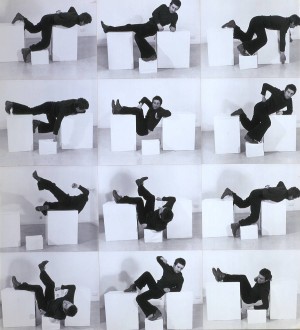You have no items in your cart. Want to get some nice things?
Go shopping
I am waiting in the auditorium in Frieze London. Before me are two chairs and a pair of plinths upon which sit matching reading glasses. It is here that “action sculptor” Bruce McLean – in a quick-fire display of seat-swapping and spectacle-switching – will interview himself.
The interview is amusing: “Can we get back to something more important?”, asks Mclean of himself. “Let’s talk about the importance of your very important work.”
There is levity here, but there’s also depth. McLean the interviewer is able to interrogate the sculptor in ways another could not. The answers McLean gives himself are interesting, but what is more remarkable, I believe, are the questions he asks himself. They highlight areas that he feels are worth unearthing, and they dig into insecurities that would be discomfiting to address with anyone else. They are thoughts spoken aloud, a fluid exchange of sentences between one McLean and the other.
This idea of responsiveness permeates Frieze. I follow Sophia Al Maria’s tour of the fair, a moving television set from which sounds the mechanized voice of our guide, warning us of hidden conspiracies, telling us to take our own path. A giant iris stares from the set; reminiscent of the unblinking gaze of The Great Gatsby’s Dr T. J. Eckleburg, it scrutinizes all within its sight.
Repeatedly, the focus of the work returns to the observer. “And what, for example, am I now seeing?”, asks a neon green sign in the Georg Kargl Gallery, a question which resonates with its viewers. Elsewhere, the Carlos/Ishikawa stand has been transformed into a garish nail parlour, offering manicures to the passing masses, while Franz Erhard Walther invites the crowd to animate his stretches of elastic in an action-based installation. The sculpture park elicits a physical response from its audience: children play beneath the belly of Matt Johnson’s Baby Dinosaur, and audacious teens take selfies with Reza Aramesh’s white marble man.
The controversial Does This Soup Taste Ambivalent? is an initiative from the United Brothers, offering soup made from vegetables grown in the region of the Fukushima nuclear disaster of 2011; its emphasis is on the participants, whose reaction to the brightly coloured broth is under observation. But there is more than one exchange at play here, for this work also makes oblique reference to the greatest use of soup in the history of contemporary art: Warhol’s celebrated canvases of Campbell’s Soup Cans.
Again and again, the pieces on display respond to powerful influences from the past. The Misako & Rosen Gallery contains a painting entitled Picasso with Pushpin #8, a Cubist portrait with pins in its eyes, and on the walls of the Barbara Seiler stand are scrawled stage directions from Waiting for Godot. An installation entitled ) pause ( occurs within the space, with four performers physically interpreting the idea of “pausing”, in a nod towards the ceaseless, purgatorial state of pause in Beckett’s play.
The fair is informed by interchanges – between McLean and Mclean, between the art and its audience, between the artists and their precursors. They are fascinating dialogues, contributing to the chattering dynamism of the tent in which the works are exhibited. And stepping into the darkness of Regent’s Park, I find that I can still hear the hum of the fair’s many conversations long after I have left it.

About Xenobe Purvis
Xenobe is a writer and a literary research assistant. Her work has appeared in the Telegraph, City AM, Asian Art Newspaper and So it Goes Magazine, and her first novel is represented by Peters Fraser & Dunlop. She and her sister curate an art and culture website with a Japanese focus: nomikomu.com.




